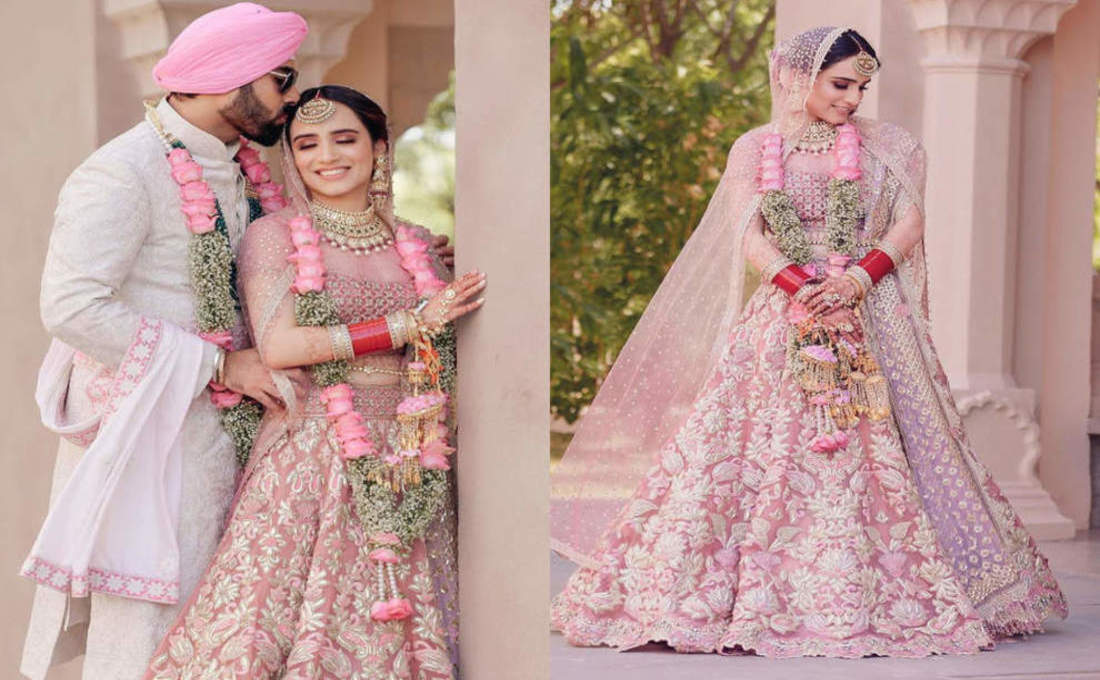
An ultimate guide to Sikh Wedding: Everything you need to know
Whenever you hear about a Sikh wedding, what is the first thing that comes first to your mind? Punjabi weddings are widely known for their loud and lively lavish wedding ceremonies full of fun, colors, food, and music. Punjabi people and culture are believed to be a bit more expressive than the rest of the Indian culture. There is a lot to enjoy while being at a Punjabi wedding. Punjabis are very particular about their wedding rituals and follow their age-old tradition. Not just this, even the Punjabi NRI’s who are residing out of India never leave a chance to celebrate their traditional wedding. Sikh Weddings offer the best glance at a combination of Asian and Hesperian values, customs, and traditions.
Are you aware of the wedding traditions ad rituals performed in a big fat Punjabi wedding? Let us take a virtual visit to a Punjabi wedding and enjoy the vibrant culture.
Punjabi Pre-Wedding Rituals
Roka & Thaka
Roka is the first ritual of the Sikh wedding. It comes from the word “Rokna” where a family from the bride’s side visits the groom’s family with sweets and gifts. This tradition is performed in the absence of the bride. Then the groom’s family visits the family of the bride. The former family brings fruits, sweets, and gifts for the bride. The couple is then made to sit together and is announced officially as a couple. The couple is then showered with blessings and offered gifts which are known as shagan or shagun. They are offered laddu. This ceremony that happens at the bride’s home is Thaka. Earlier this ceremony was an intimate affair at each other’s home but now most people consider performing this at one place together.
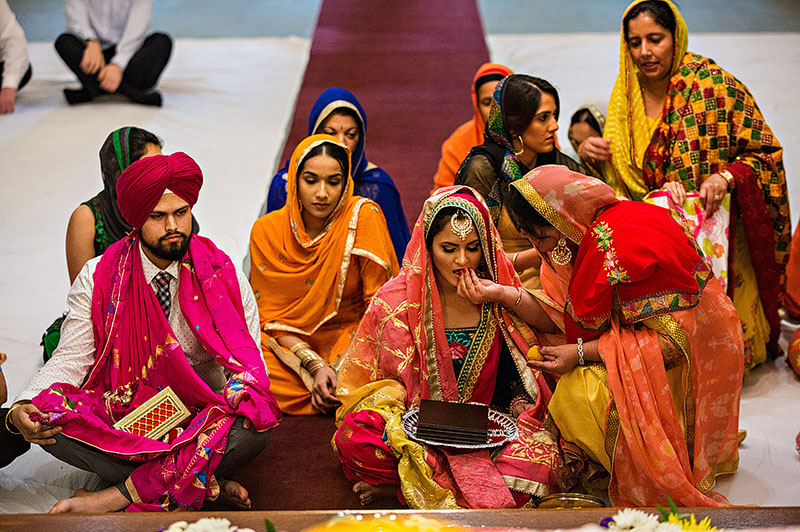
Chunni Chadhana
This is the formal ceremony before the engagement where the bride and groom are announced soon to be married. The family and relatives of the Groom visit the Bride’s home with the red outfit, bangles, Chunni, jewelry, and makeup that the bride will be wearing on her wedding day. The groom’s mother put the chunni on the bride’s head as a veil. This is Chunni chadhana. Then Mehendi is applied to the hands of the bride. Then father of the groom put dry fruits in the jholi of the bride and the father of the latter put mewa (dry fruits) in the jholi of the groom.
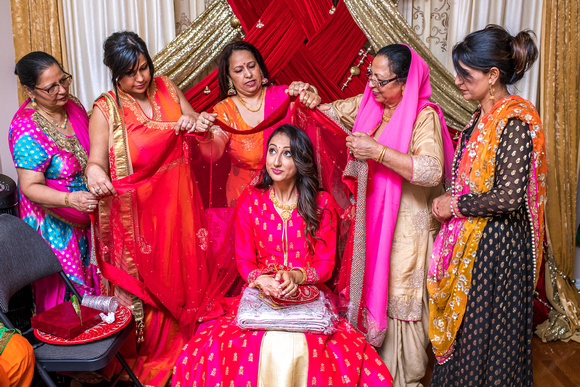
Kurmai
Kurmai ceremony is one of the auspicious ones that is held either at the groom’s residence or at Gurudwara in the presence of close friends and family. The granthi will start the Ardas, later to which the sister of the groom put a cloth or palla on his shoulder into which the father of the girl will put dry fruits and a Kada on his wrist. The ceremony ends when fathers of both bride and groom exchange garlands.
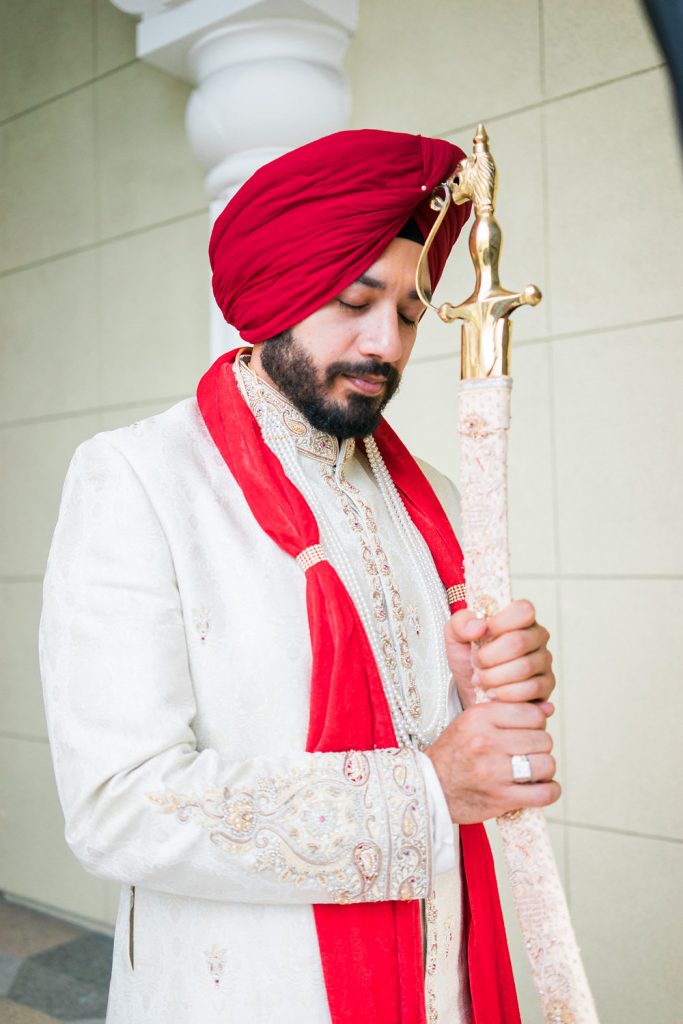
Engagement
It is one of the common wedding rituals of all Indian weddings where the bride and groom exchange rings in the presence of close friends, relatives, and family. Once the couple exchanges the rings, the guests give those gifts and shower their blessings on the couple.
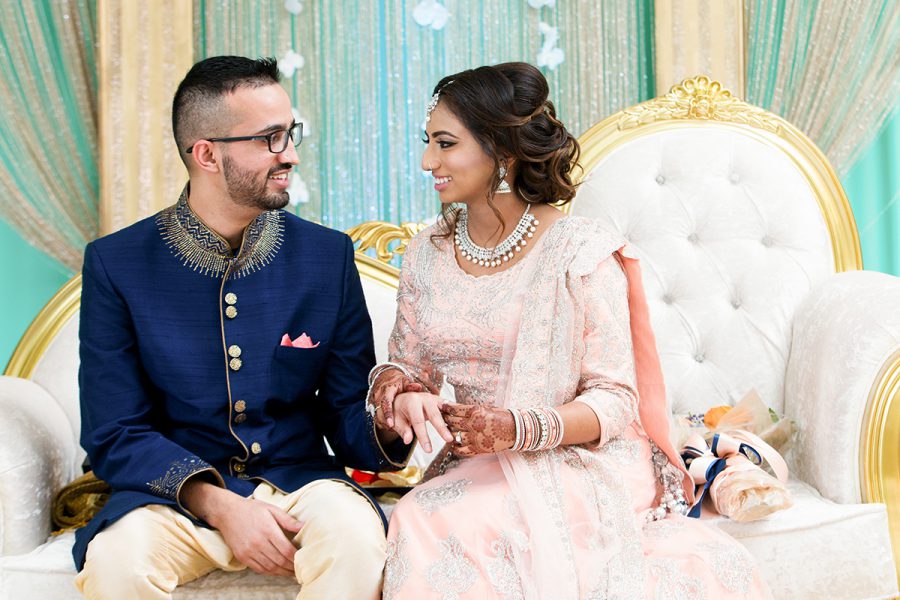
Shagun and Saha Patr
The bride’s family organize a special wedding invitation speckled with kesar. A few of the important family members take it to the groom’s house. Their visit is usually made carrying invitations with gifts like dry fruits, fruits, sweets, clothes, and a sacred coconut. The intent of this is to officially invite the groom and his family and to inform them commencement of the wedding preparations.
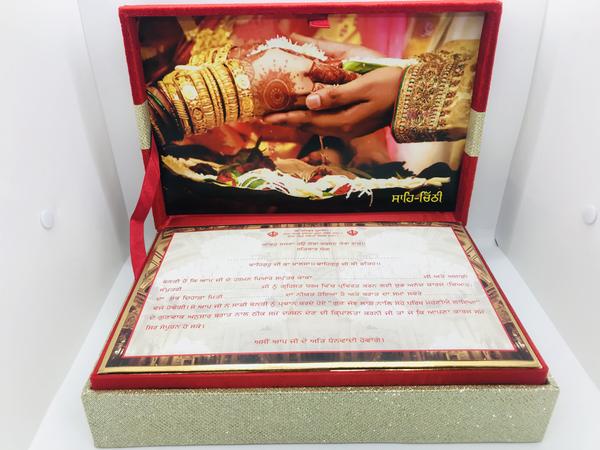
Akhand Path
Akhand Path is the reading of “Guru Granth Sahib”, the holy book of Sikhs, for 48 hours continuously prior to the wedding date. Both families organize paths separately. After the path, kirtan is conducted where religious hymns and songs are sung. In the end, ardas is made, and Karah Prasad is distributed among all.
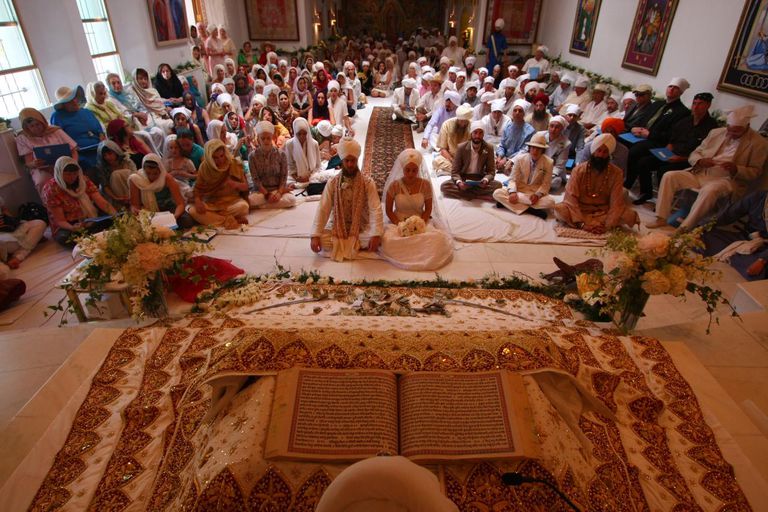
Mehendi Ceremony
Every bride ever loves this ceremony where she applies henna or Mehendi on her hands and legs. Either someone from the family or any Mehendi artist is called to apply the beautiful Mehendi design. Along with the bride, her friends, sisters, cousins or any other ladies can also apply henna to their hands on this day.
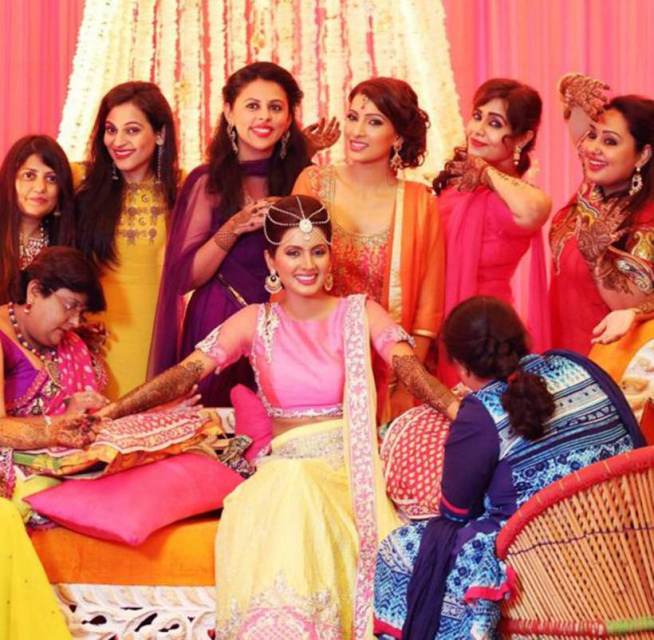
Ladies Sangeet
In ladies sangeet, ladies who are close to bride and groom, sing and dance at night. It is almost similar to a bachelor party. Along with the enjoyment, light snacks as refreshments are also distributed among all.
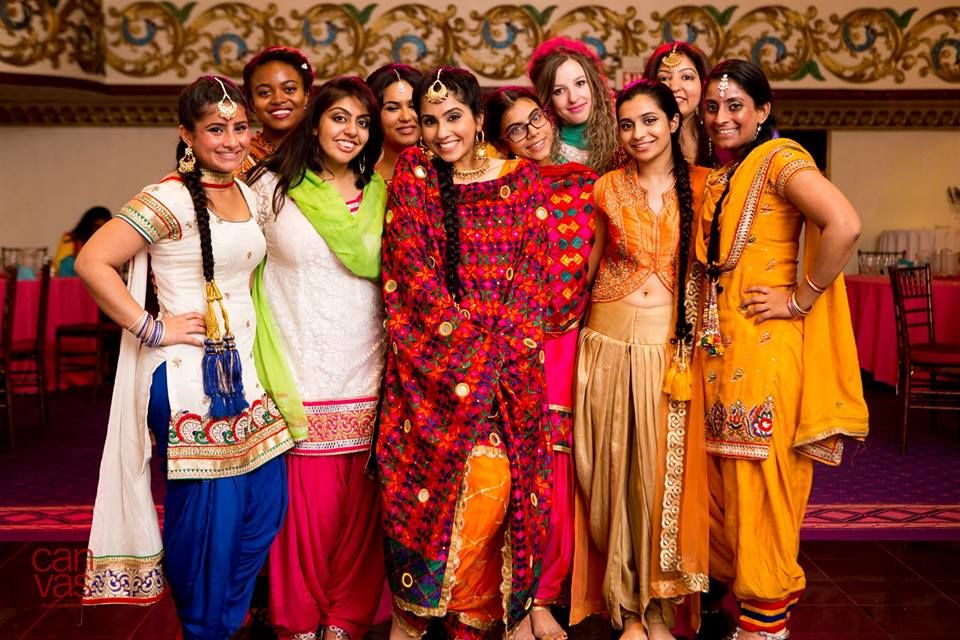
Jaago
Jaago means to wake up. In this ceremony, a night before the Sikh wedding, relatives of the bride and groom sing songs, dance with decorated pots and diyas the whole night. Other villagers and neighbors are also called for this event. The purpose of this ritual is to make noise all night and party. Bamboo sticks and chaj are banged until they break.
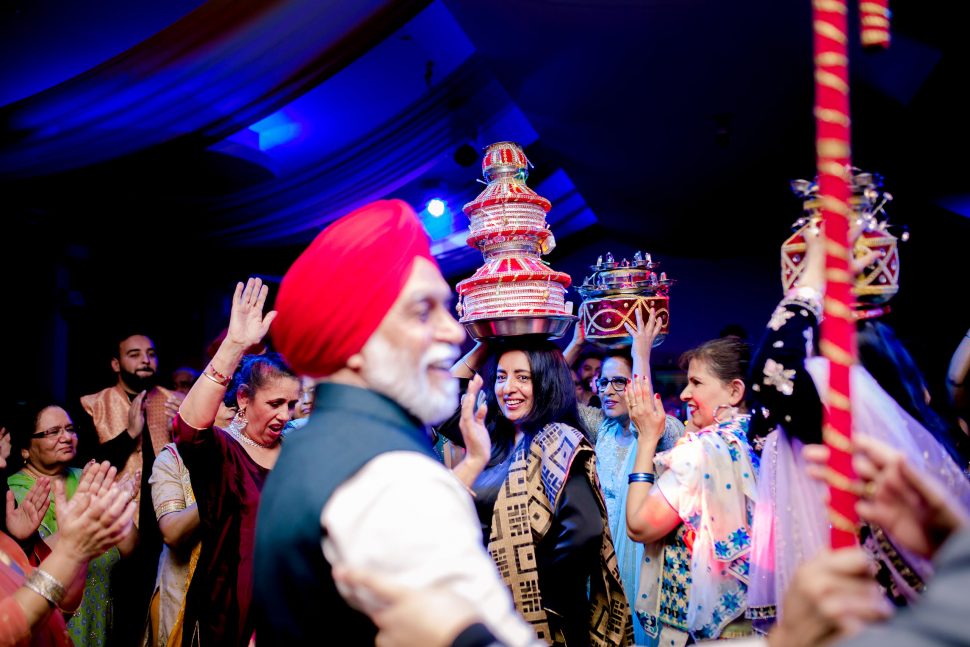
Sikh Wedding Day Ceremony
Kangana Bandhana
This is the first ceremony held on the day of the wedding. This mouli (a pure sacred thread) is tied to the bride and groom’s hand by a priest. This Kangana or mouli has to be there until it itself falls off.
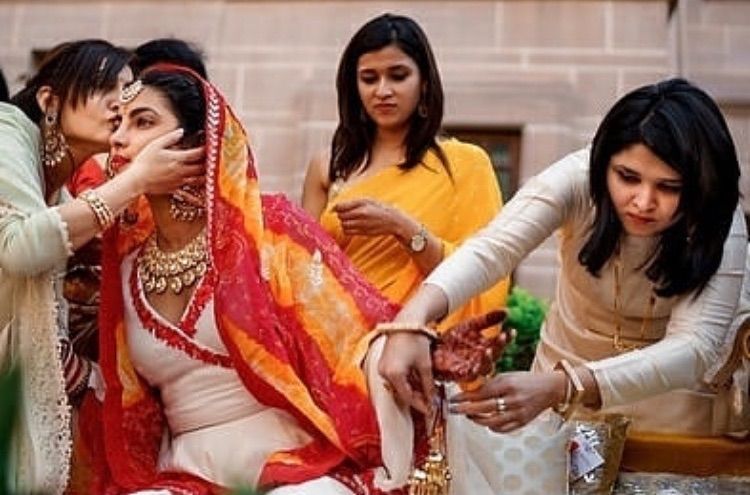
Chooda Chadhana
In this ceremony, the maternal uncle or mama of the girl with his wife presents a set of 21 red and ivory bangles to the bride. The bangles are first dipped in milk and rose petals that are later put on the wrist of the bride. Then immediately those bangles are covered with a white cloth so that the girl doesn’t see them.
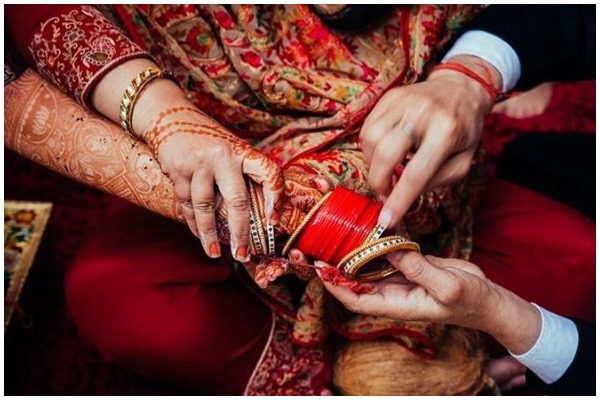
Kalire Ceremony
It is a kind of fun ceremony held between the bride, her sisters, and female friends. Kalire is tied to her hands that are a symbol of fertility and lively life. Once kalire is tied to the bride’s wrists, she shakes and tries to shower it on other girls. On whom the kalire falls off by breaking will be the next girl to get married.
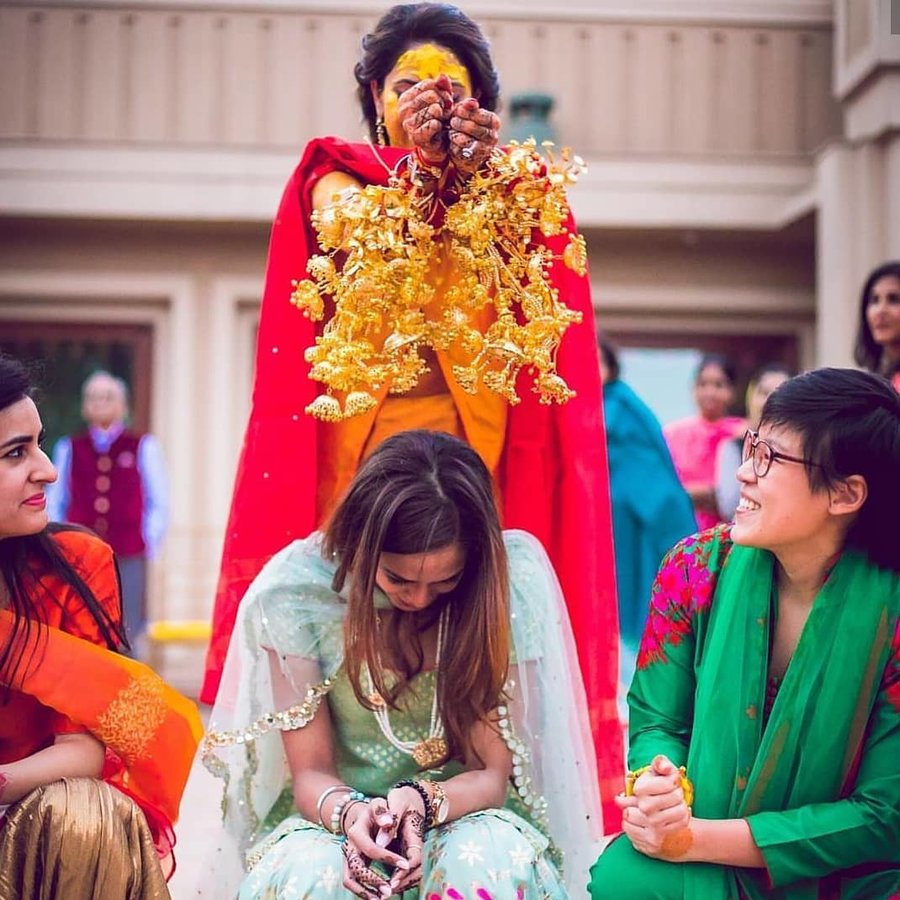
Maiyan/Vatna
A colorful rangoli is prepared on the floor. The maternal relatives of both bride and groom usually make it. A peerhi is placed near to it on which bride and groom will sit at their respective home. They are then made to sit on a peerhi with a tray filled with decorative items.
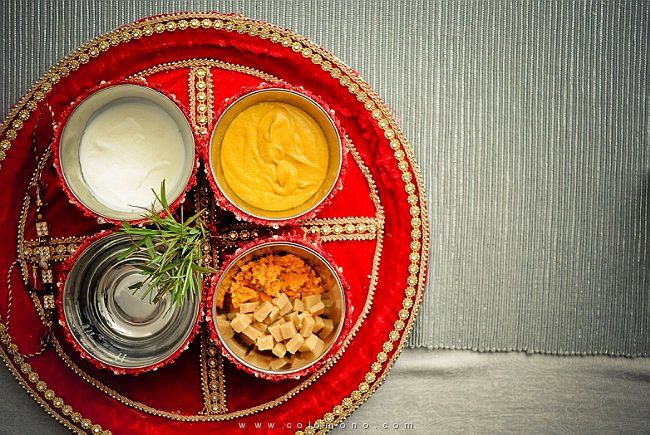
Haldi Ceremony
It is again a ceremony that happens in most Indian weddings. In this, a paste of turmeric is prepared with rose water, sandalwood, and mustard oil. It is then applied to the arms, legs, and cheeks of the bride and groom separately.
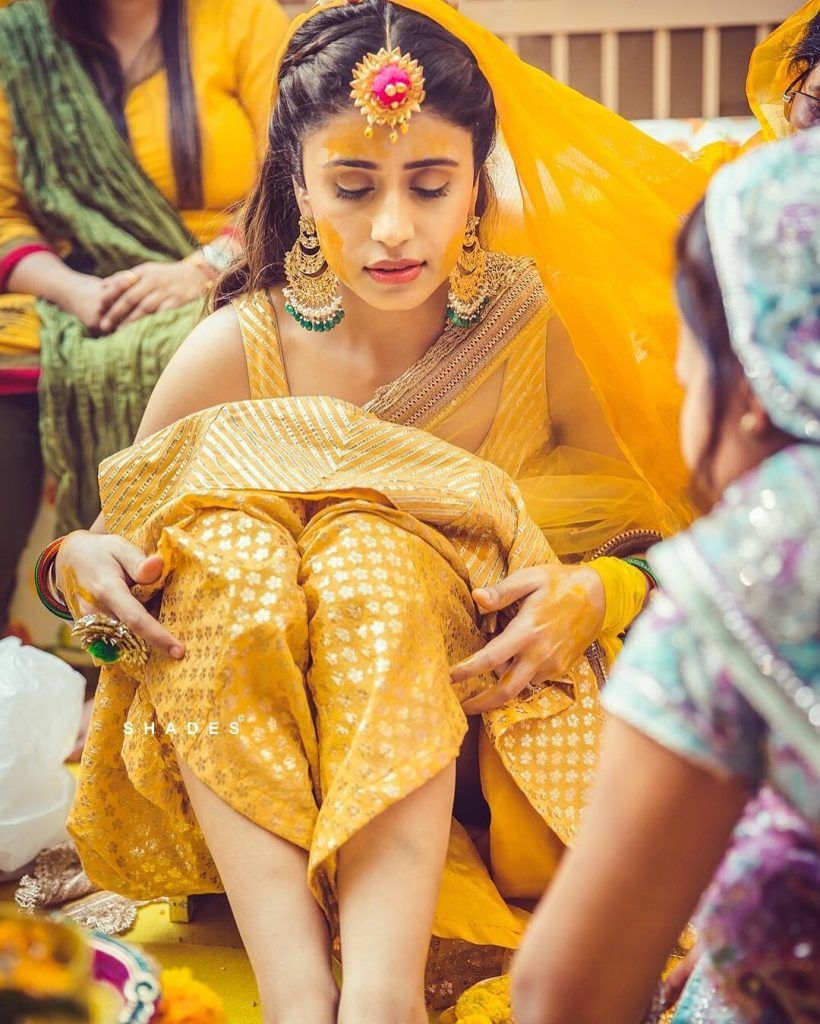
Ghara Gharoli
After the Haldi ceremony, the bride visits the nearby temple where sacred and pure water is poured over her. Then she enters the temple to take the blessings from God and then return back to her home.
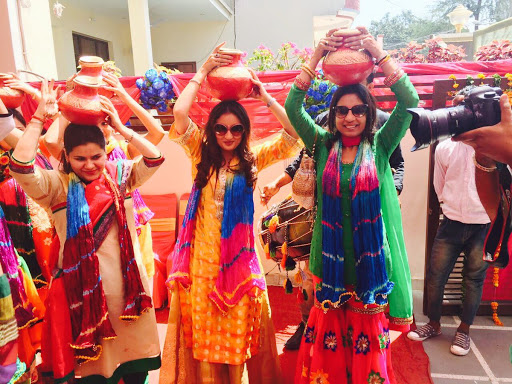
Sehrabandi
In sehrabandi, once the groom is ready for the wedding he takes the blessings of all the deities and elder members of the family. A pink turban cloth is worshipped that is called sehra and then is wrapped around the head of the groom. The sehra is then tied to his head that has strings and his face is partially visible in it.
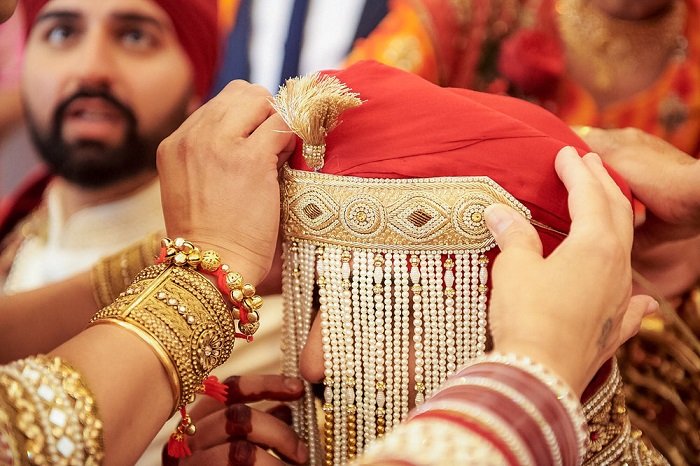
Ghodi Sajana and Ghodi Chadhana
The baraat comprises the groom who rides his horse on which he enters the wedding venue where the ceremonies take place, and his close family and friends dancing as a part of the procession. Before proceeding with the journey on the mare, she is decorated and offered chickpeas and jaggery.
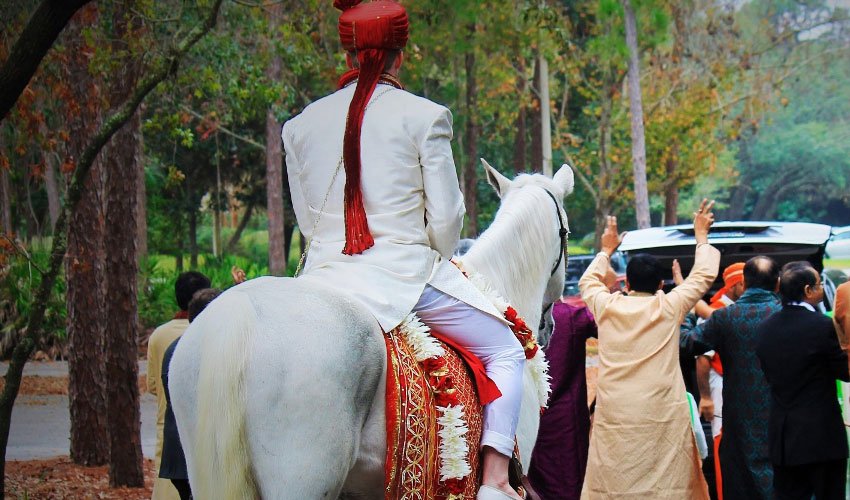
Agwaani and Milni
It is one of the most important traditions in Punjabi weddings. The family from the bride’s side welcomes the baraatis which sometimes includes aarti too. Then all the members of the corresponding family greet and meet each other. There is then an exchange of gifts or grooms relatives are sometimes offered some money known as milni.
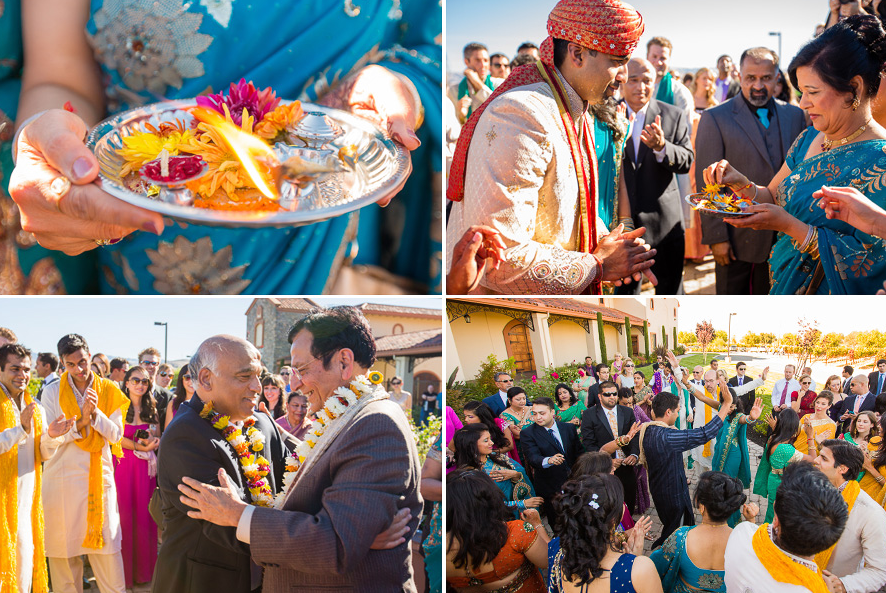
Varmaala
After the groom enters the venue, the bride is called for another ceremony. It is called Varmaala or Jaimala. In this both bride and groom exchange garlands.
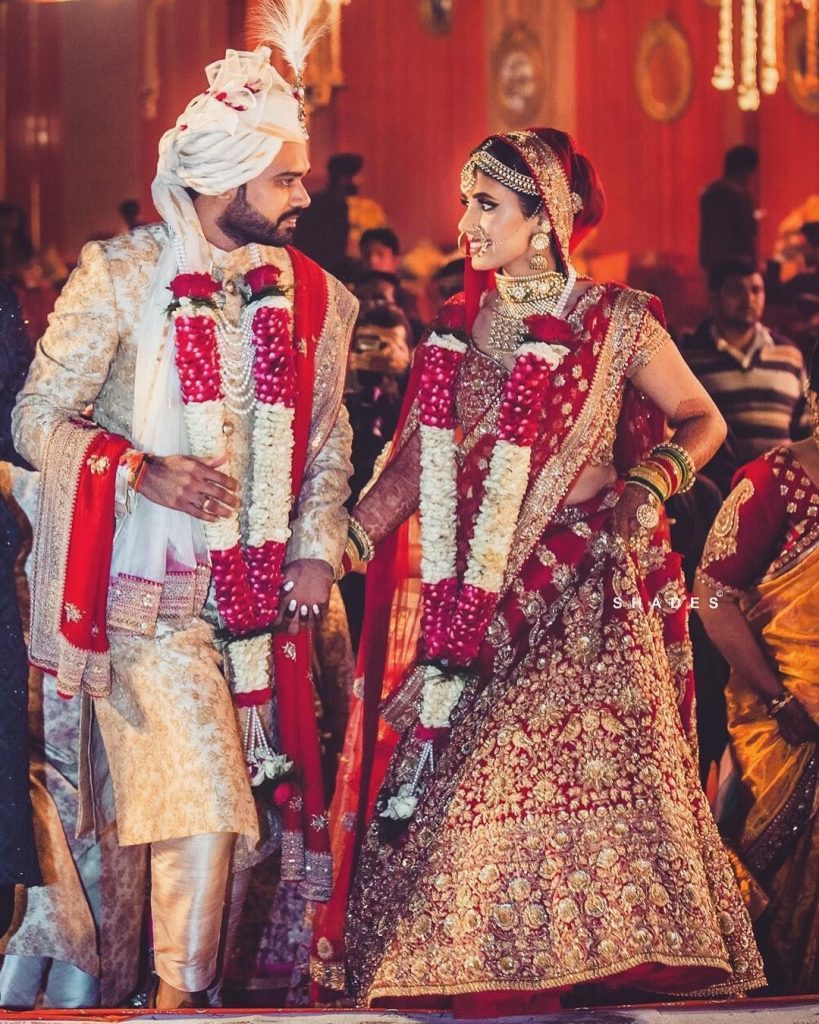
Madhuperk/Madhuperka tradition of Sikh Wedding
After the garlands are exchanged, the bride and the groom are made to sit around the sacred fire. The bride first proffers the groom a bowl of water. He splashed some droplets first on his feet, then the body, and ultimately drinks the rest.
Then the groom is given a sharbat called madhuperk, prepared from ghee, curd, honey, and some essence to drink. He takes it and shower some in all directions and then slowly sips it.
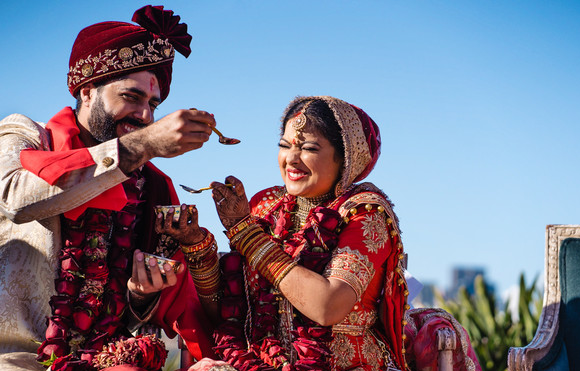
Kanyadan
This is an emotional moment for the bride and her parents. The bride’s father gives the hand of the bride the groom’s hand and asks him to treat her well with all of his love, care, respect, and security.
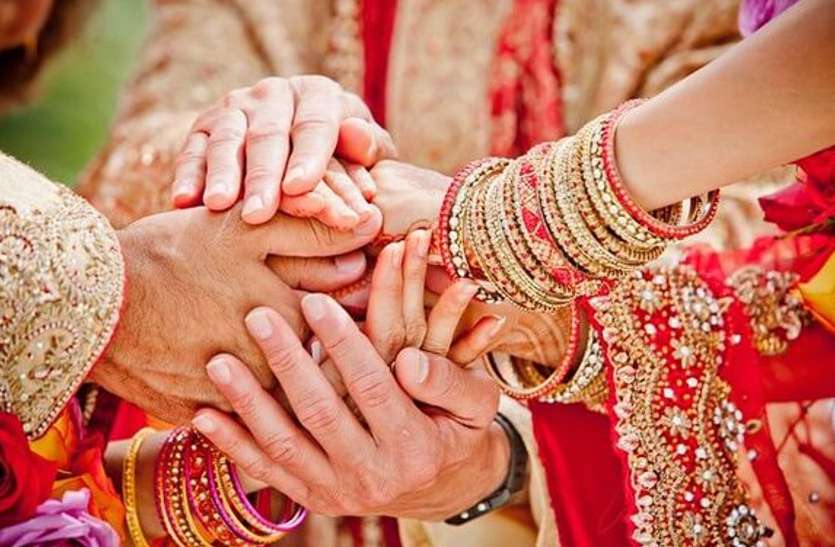
Laavan Phere
It is a prayer of four vows that confirms the marriage. One end from the dupatta of the bride is tied to the shawl or dupatta on the groom’s shoulder. They then take four pheras or circles of Guru Granth Sahib.
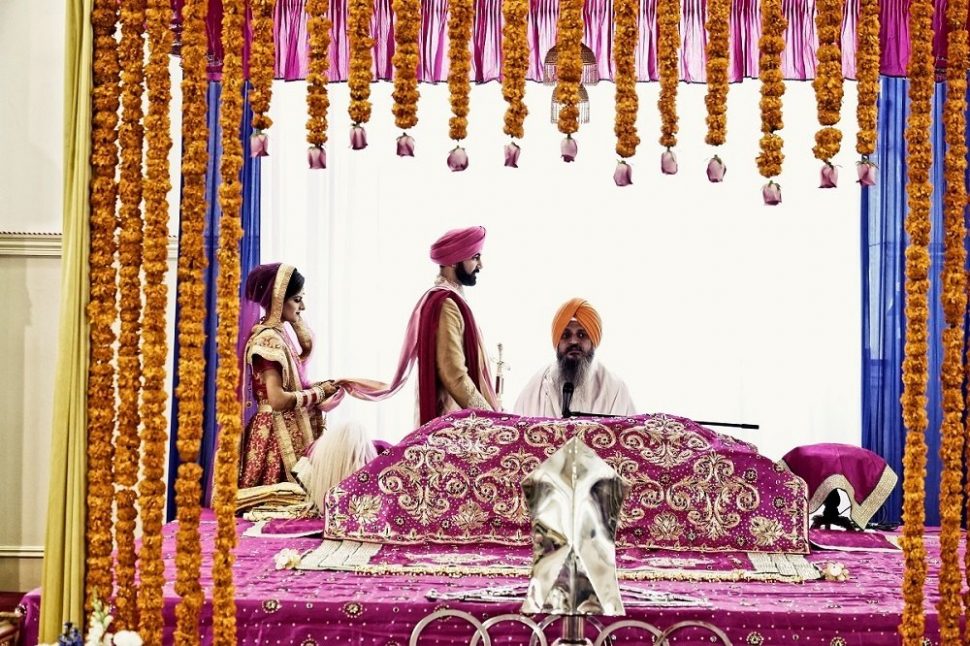
Joota Chupai
While the groom is busy with the rituals, the sisters and brothers of the bride hide his shoes and then demand money in exchange for those, if he wants them back. After some bargaining they arrive at an amount considered by both the parties and are then exchanged with the shoes.
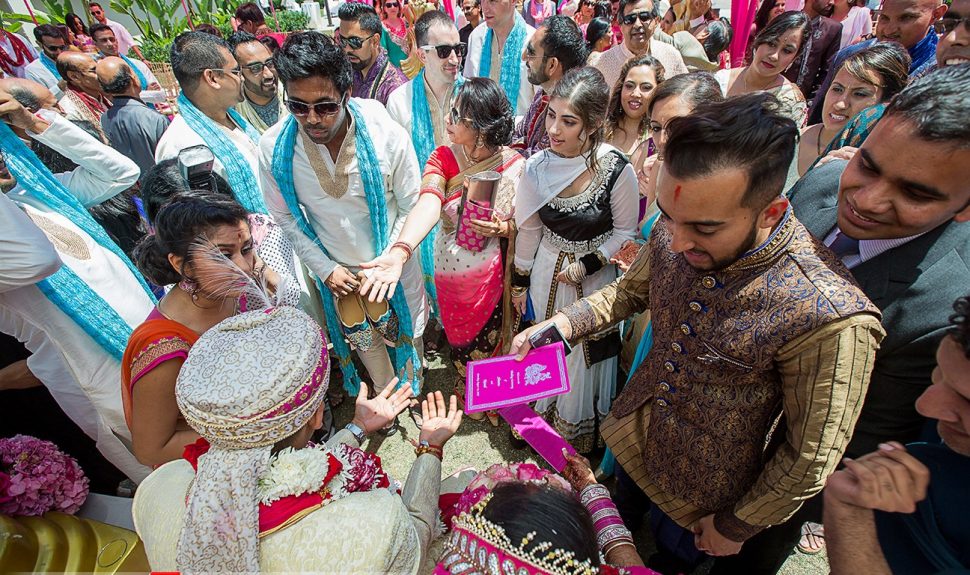
Post wedding rituals
Vidaai
Viddai is the overwhelming part of every wedding. Now the time has come when the bride has to say goodbye to her family and move to the new one. The new family with new people will be now her family and she has to live there for the rest of her life.
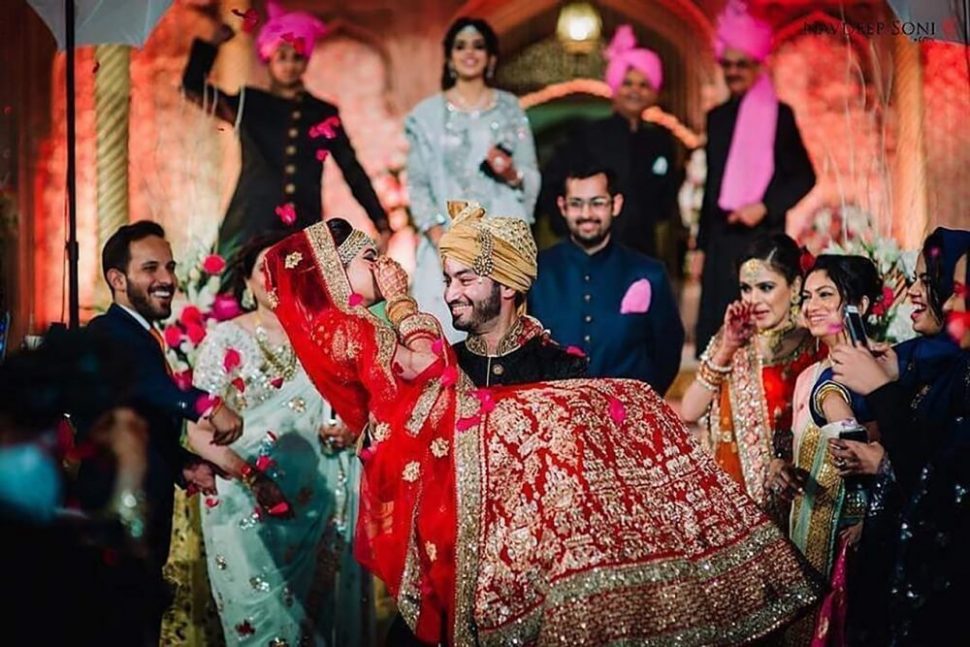
Paani Varna ritual of Sikh Wedding
It is the first Sikh Wedding ceremony that happens with the bride and groom together after the wedding in the groom’s house. On their arrival at the entrance of the house, the groom’s mother does aarti of them with a utensil filled with water. After each circle, the groom’s mother tries to drink that water, but the bride has to stop her. And mother is allowed to drink water only on the seventh circle. The bride is then welcomed in the house and she enters by leaving her footprints colored with the red lac dyed water and then visit the temple of the house to take blessings.
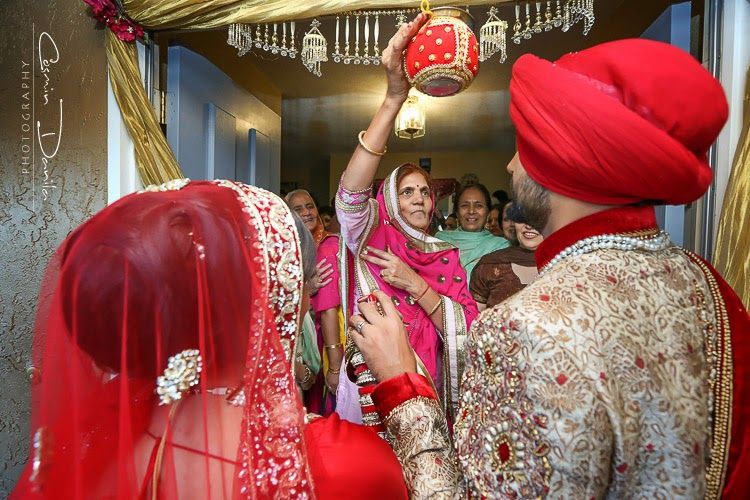
Mooh Dikhai
In this Sikh Wedding ceremony, the bride is introduced to the groom’s relatives and neighbors for the first time. The mother-in-law of the bride offers her gifts and jewelry and other elders also present her gifts.
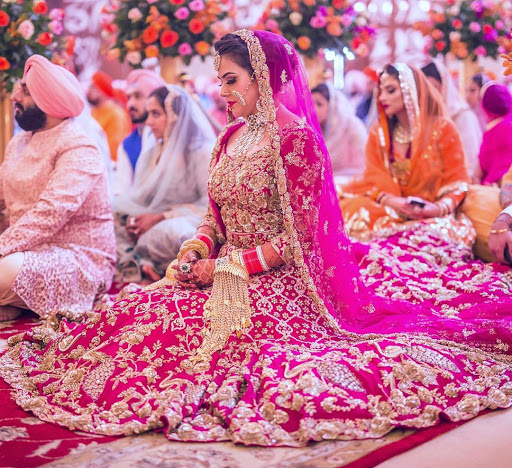
Reception
In the honor of the new couple, the guy’s family throws a grand reception party at their residence, where guests are invited to meet the new couple. It is a night of fun and excitement. Everyone enjoys, dance, and celebrate the union of the couple.
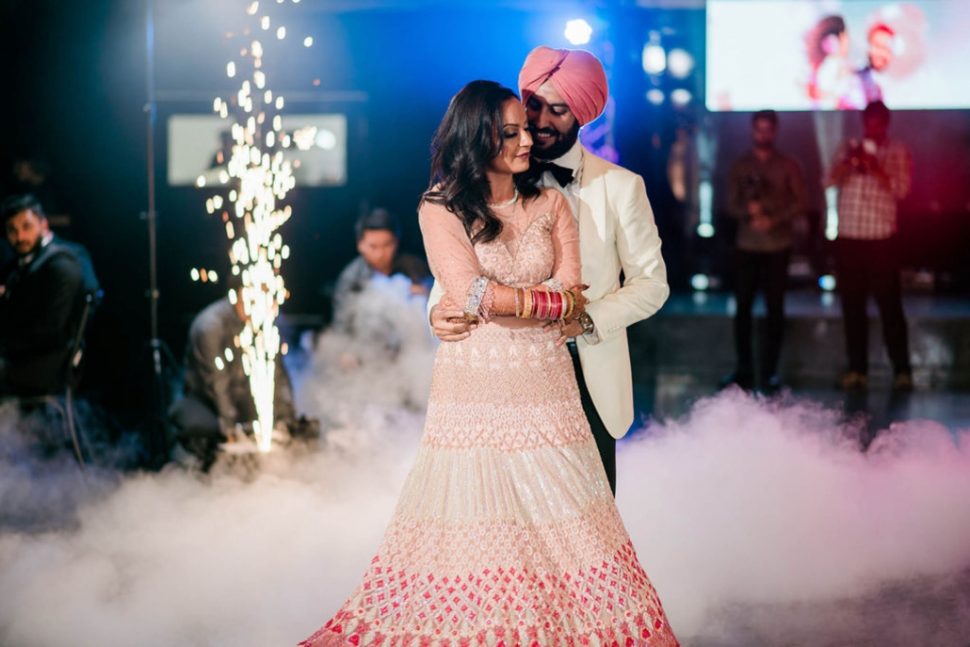
Pag Phera
A day after the wedding day or next to the reception, the bride and groom are invited to the bride’s house for a small gathering. The family of the bride visits the groom’s home to take her back for the event of pag phera.
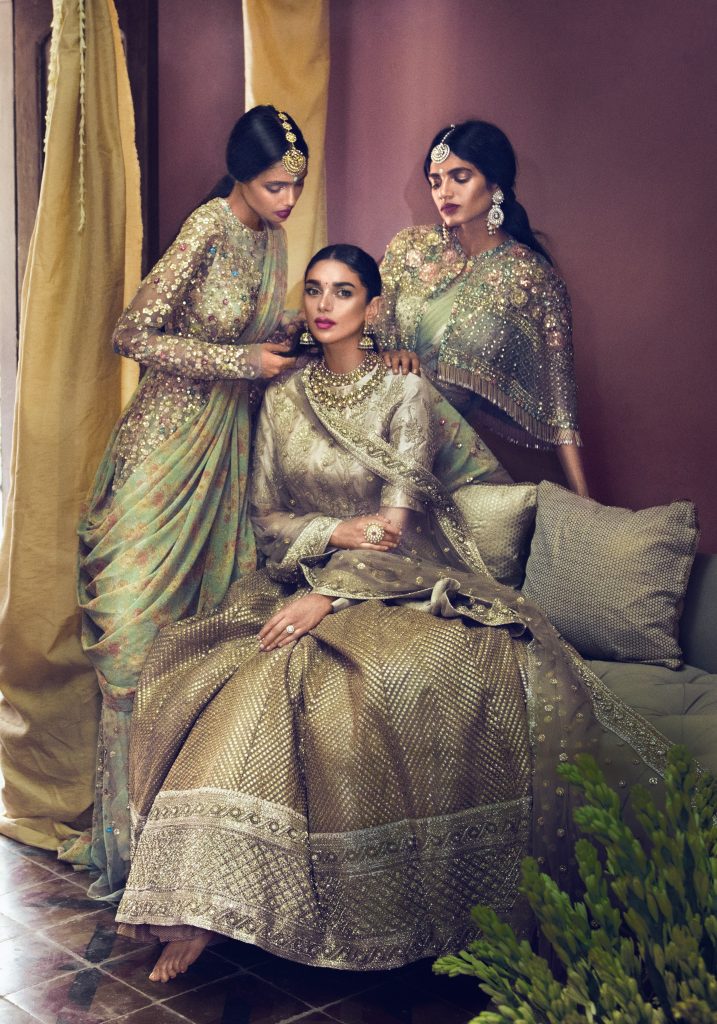
This calls for the end of the rituals of the Sikh wedding. Hope you must have enjoyed this virtual tour. Let us know your experience with this.


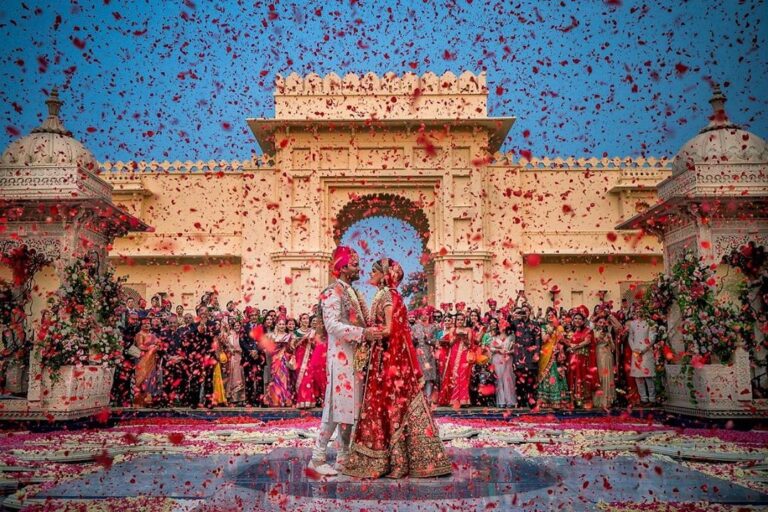
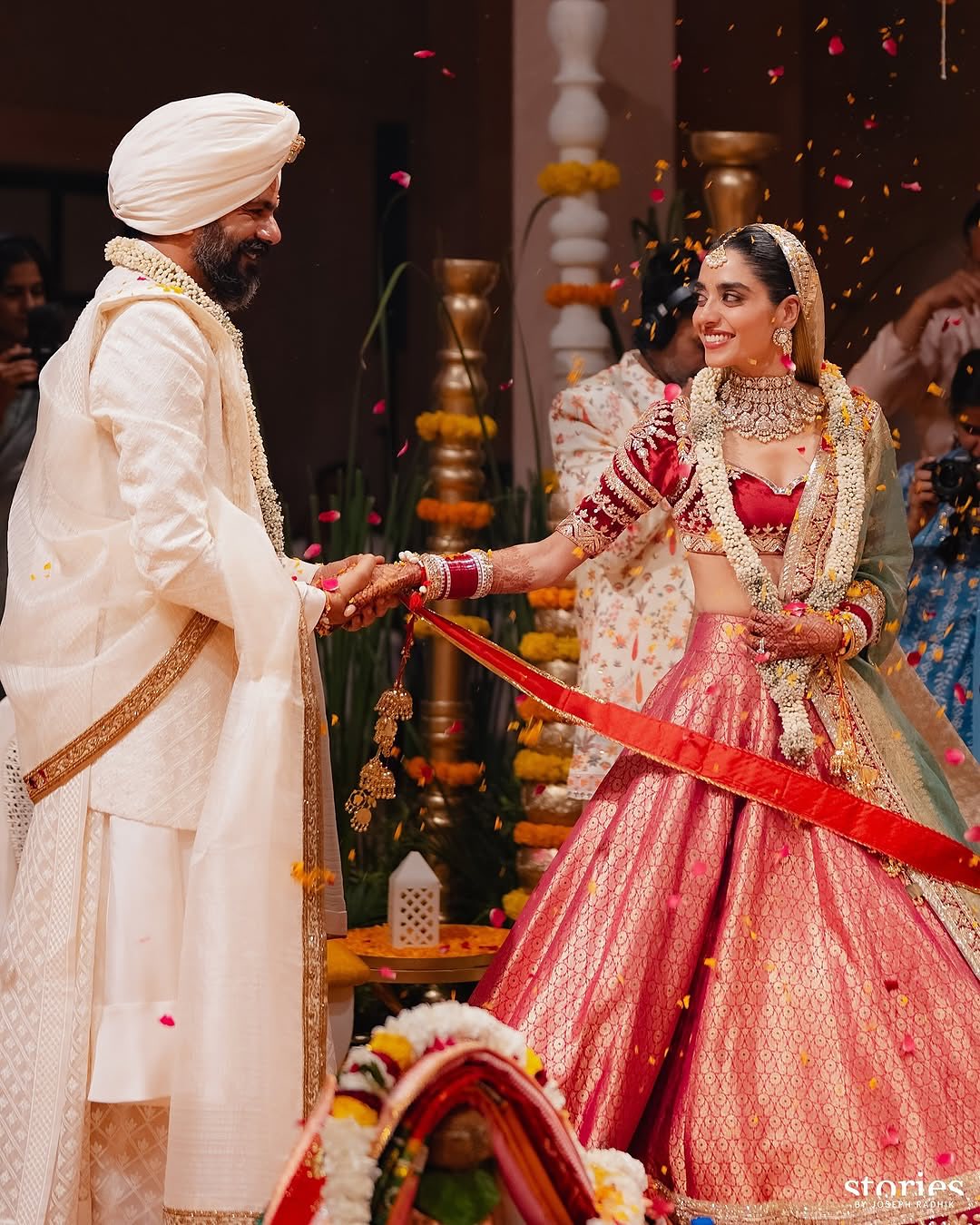
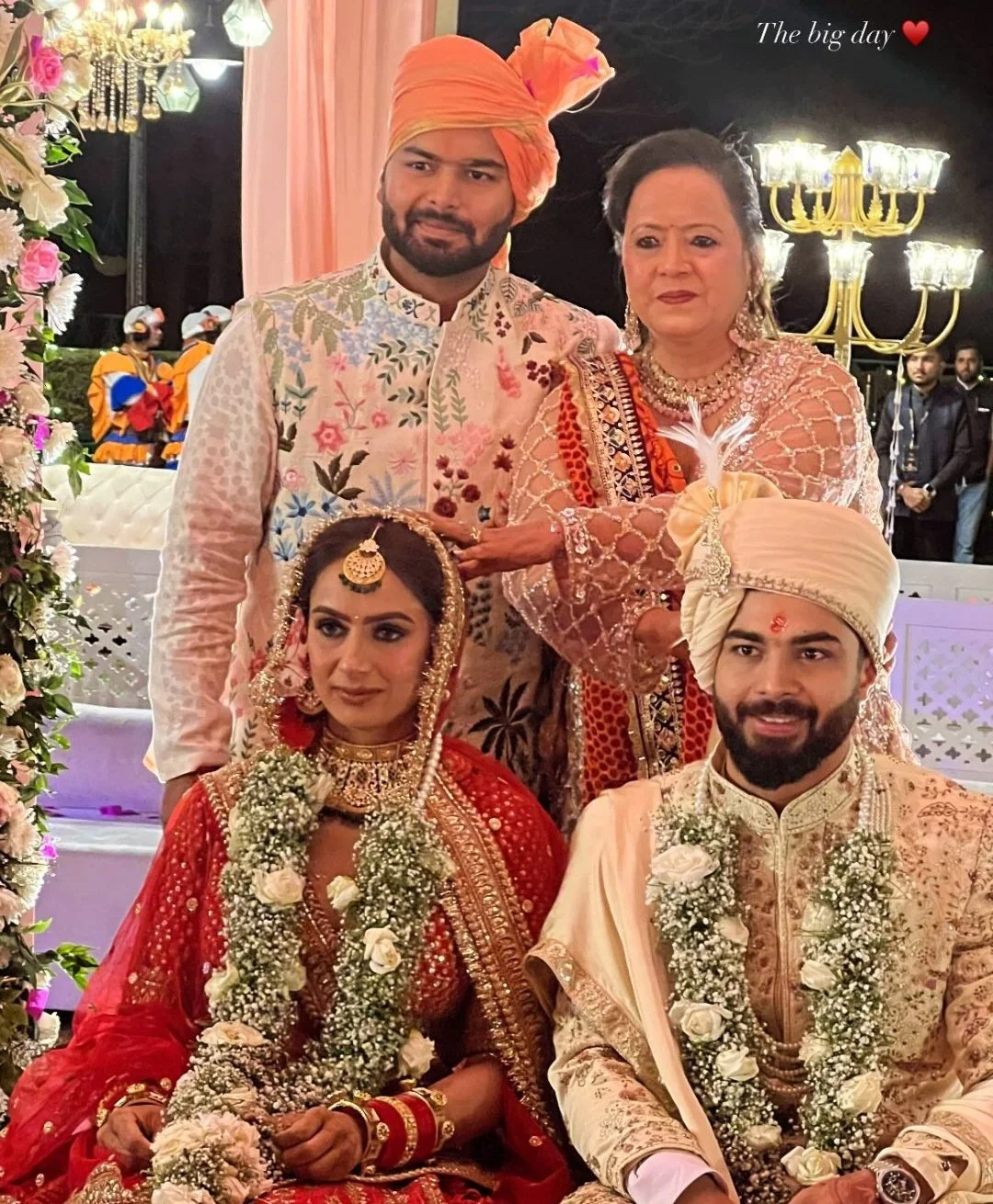
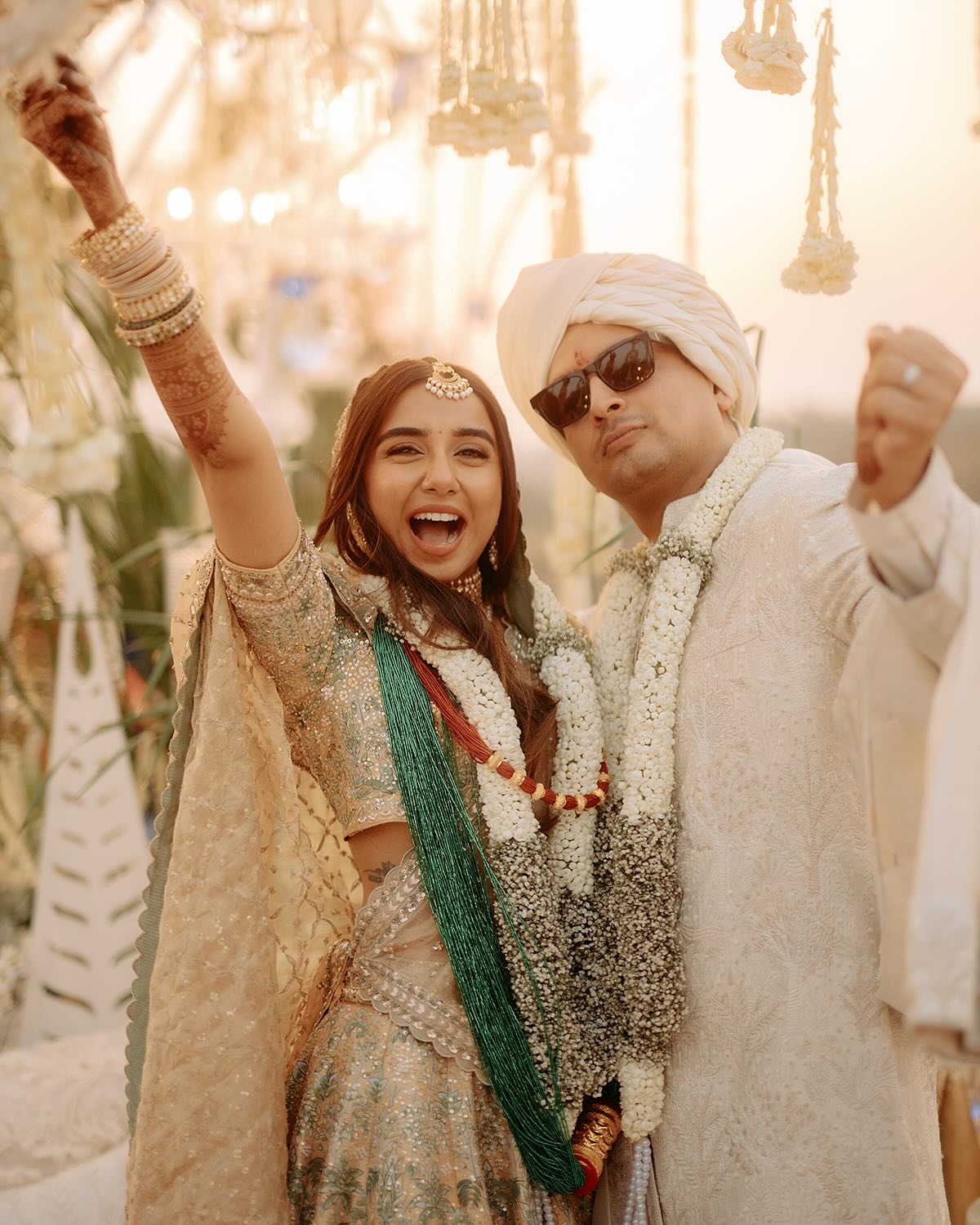
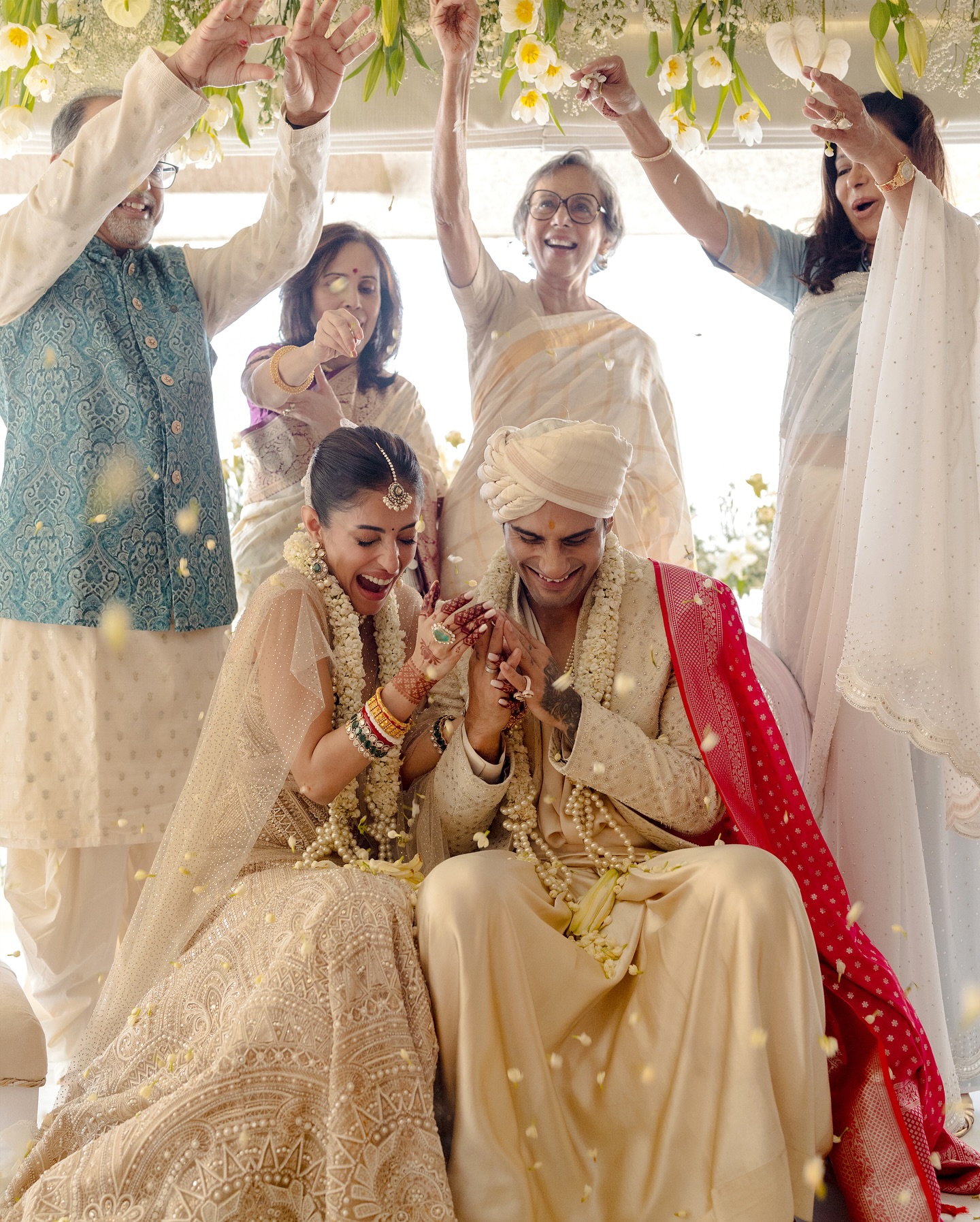
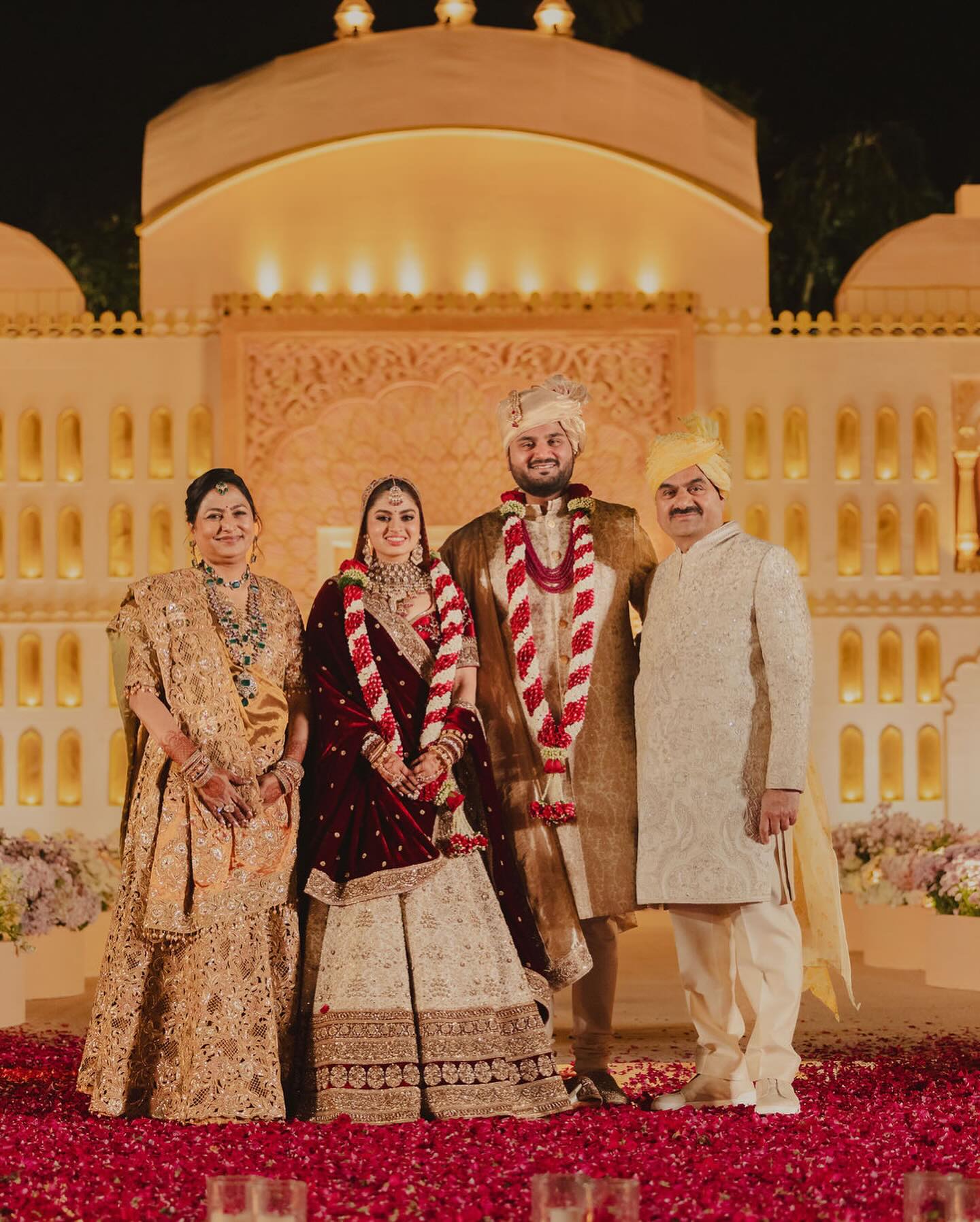
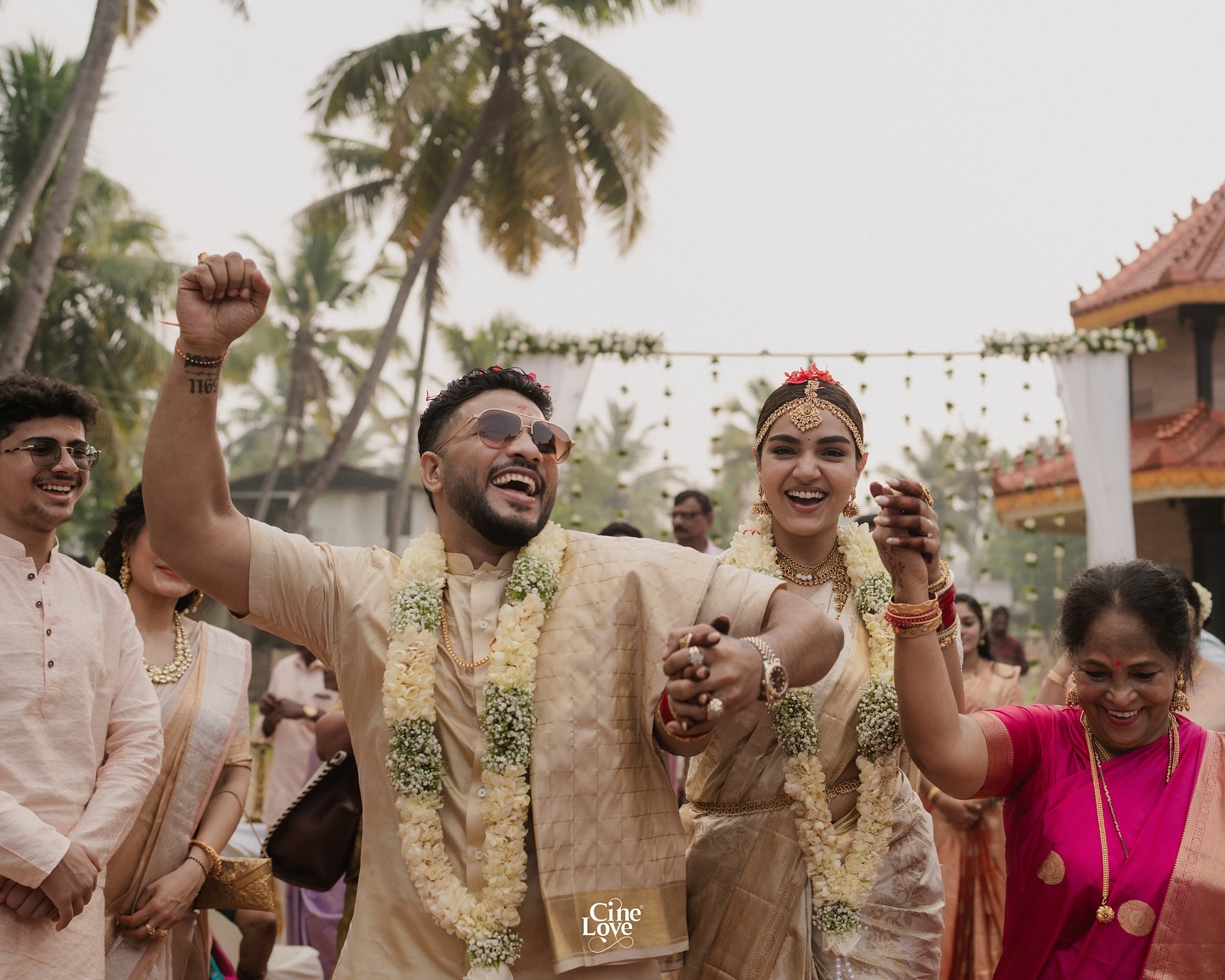
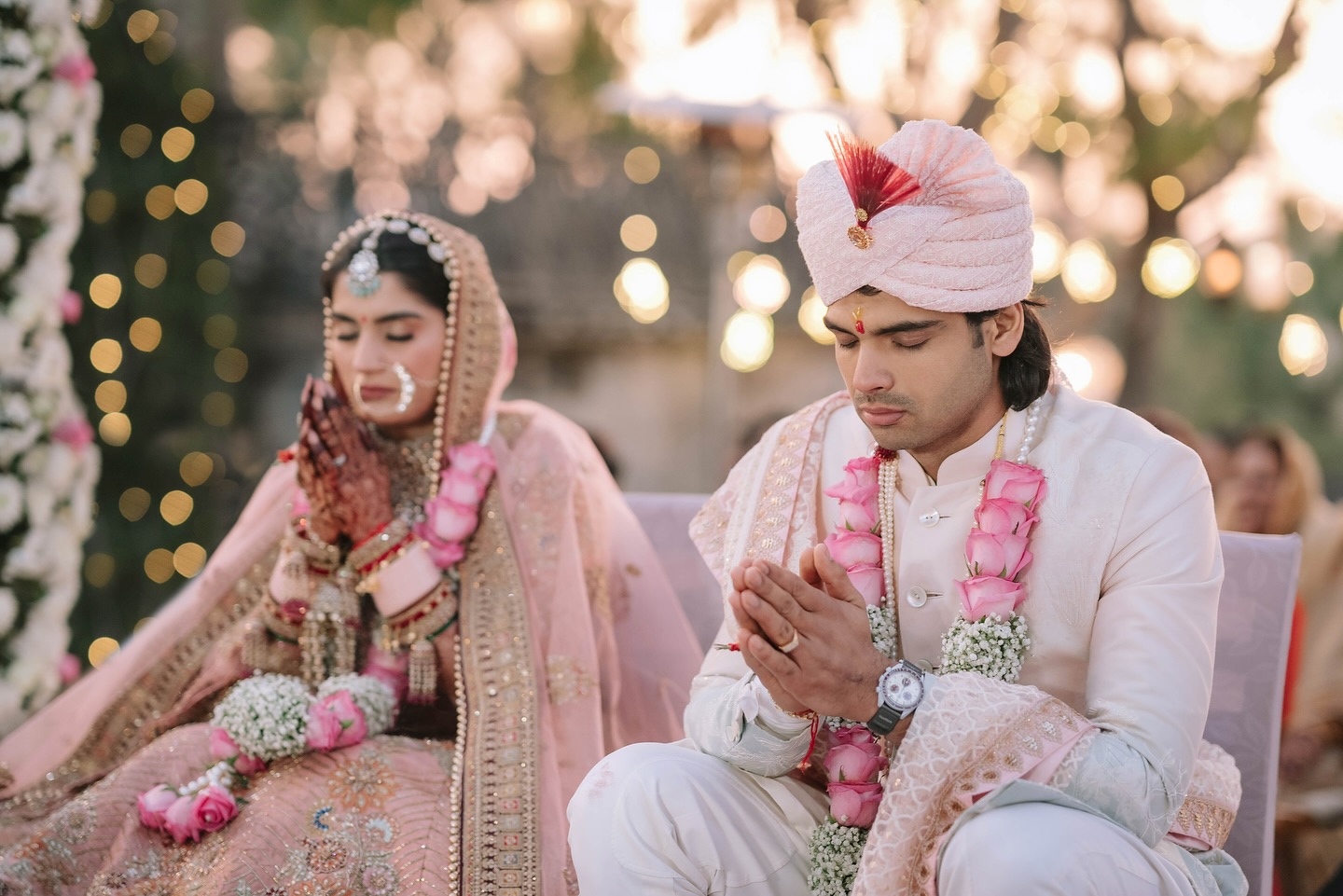
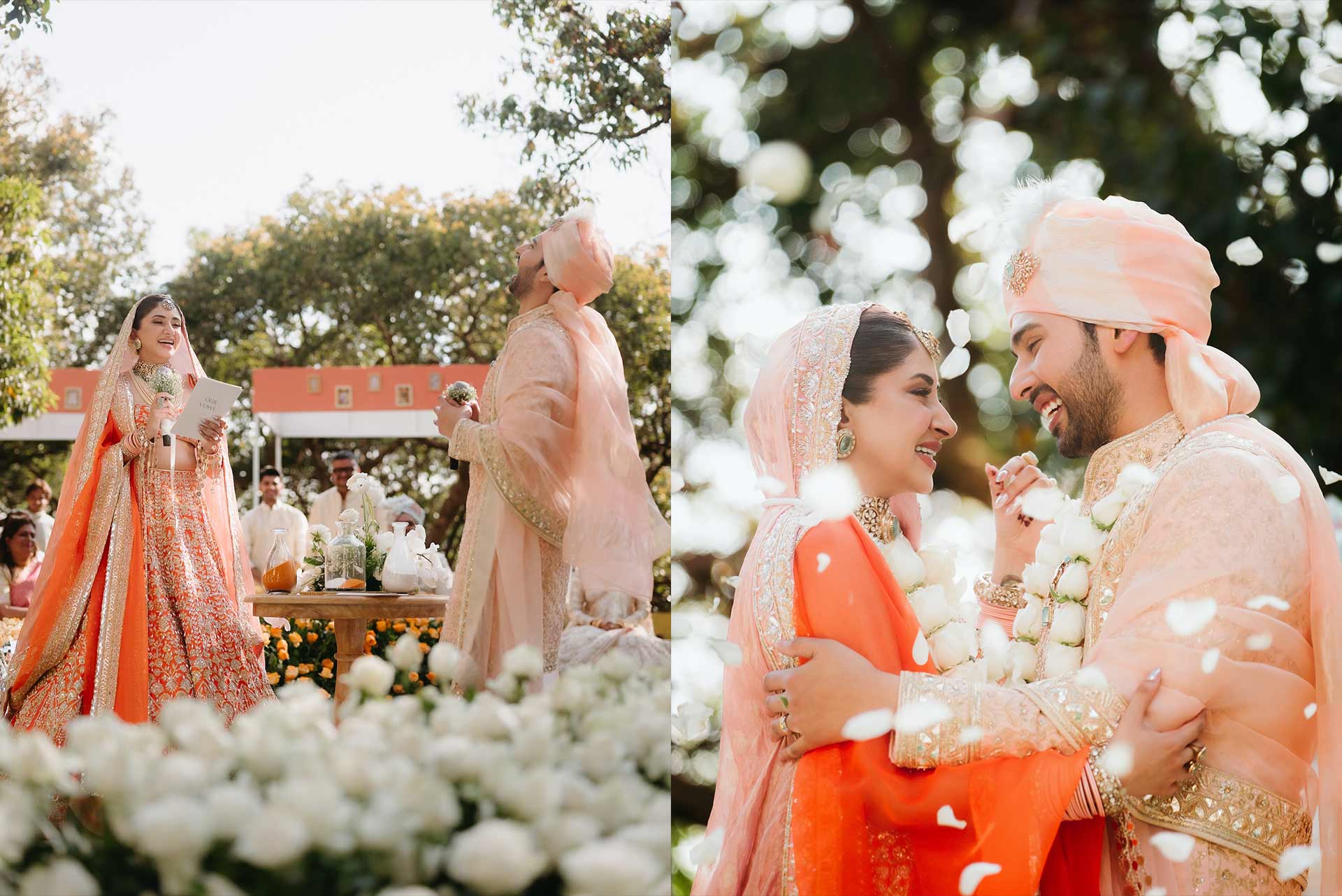



Your feedback